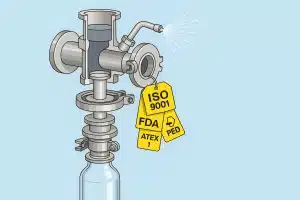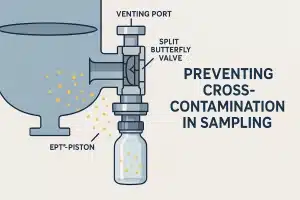In the world of fluid dynamics and engineering, valves play a crucial role in managing the flow of liquids and gases. Understanding the various types of valves and their specific applications can significantly enhance system performance and efficiency. This guide will explore the most common valve types, their unique characteristics, and where they are best applied.
What Are Valves?
Valves are mechanical devices that direct the flow of fluids by opening, closing, or partially obstructing passageways. They are essential components in various industries, including oil and gas, water treatment, manufacturing, and HVAC systems. By managing flow and pressure, valves help maintain system stability and safety.
The Roles of Valves in Industrial and Domestic Systems
Key Valve Types and Their Applications
1. Gate Valves
Overview: Gate valves are primarily used for on/off control. They consist of a wedge-shaped gate that moves up and down to open or close the flow path.
Applications: Commonly found in water supply systems, oil pipelines, and gas distribution networks, gate valves are ideal for applications where straightforward operation is necessary. When fully closed, a gate valve creates a tight seal, minimizing leakage, making them a popular choice in high-pressure piping systems. They are not suitable for throttling purposes, as partially opened gate valves can cause damage over time.
2. Globe Valves
Overview: Globe valves, often made of stainless steel for their durability and resistance to corrosion, are designed for throttling and flow control. They have a spherical body and a movable disk that can adjust to manage fluid flow.
Applications: These valves are commonly used in steam, water, oil, and gas applications. Their ability to provide precise flow control makes them ideal for applications in power plants, chemical processing, and HVAC systems. Globe valves are particularly effective in systems that require a consistent flow rate, as they can easily adjust flow without causing significant pressure drop.
3. Ball Valves
Overview: Ball valves use a spherical disc, or ball, that pivots to open or close the flow. They are known for their quick operation and tight sealing capabilities, making them ideal for on/off applications.
Applications: Ball valves are widely used in applications where quick shut-off is necessary, including plumbing, oil and gas services, and food processing. Their durability and reliability make them suitable for high-pressure environments. In many cases, a quarter turn of the handle is all that is needed to close the valve, providing quick and efficient operation. The variety of ball valves available allows for versatility in different applications.
4. Butterfly Valves
Overview: Butterfly valves consist of a rotating disc that manages flow. They are compact and lightweight, making them suitable for large pipelines.
Applications: Commonly used in water distribution, wastewater treatment, and the chemical industry, butterfly valves offer quick operation and lower pressure drops, making them efficient choices for large-scale systems. Butterfly valves are particularly favored in large piping systems where space is limited, as their design allows for efficient use of space and materials. Their ability to manage flow with minimal resistance makes them a preferred option in many modern installations.
5. Check Valves
Overview: Check valves allow fluid to flow in one direction while preventing backflow. They operate automatically based on the flow direction.
Applications: These valves are essential in applications such as pump discharge lines, water treatment facilities, and plumbing systems to prevent contamination and damage caused by backflow. They are crucial for maintaining the integrity of systems by ensuring that fluids do not reverse direction unexpectedly. Check valves help protect equipment from damage and maintain system efficiency.
6. Pressure Relief Valves
Overview: Pressure relief valves protect systems from overpressure conditions by releasing excess pressure automatically.
Applications: These are critical in industries like oil and gas, chemical processing, and power generation, where maintaining safe pressure levels is essential to prevent accidents and equipment damage. They play a vital role in ensuring the safety and reliability of various processes by managing flow and preventing potentially dangerous situations.
7. Solenoid Valves
Overview: Solenoid valves are electrically actuated valves used for managing fluid flow. They are quick to operate and can be automated easily.
Applications: Commonly found in irrigation systems, HVAC controls, and pneumatic systems, solenoid valves are ideal for applications requiring remote operation and quick response times. Their design allows for precise control over the flow of fluids in automated systems, enhancing efficiency and responsiveness.
8. Pinch Valves
Overview: Pinch valves control flow by pinching a flexible tube. When the valve is closed, the tube is compressed, stopping flow.
Applications: These valves are perfect for handling slurries, powders, and other granular materials. They are widely used in the food processing, pharmaceutical, and mining industries. Their ability to fully close ensures that no material escapes during operation, making them ideal for applications where contamination is a concern.
9. Diaphragm Valves
Overview: Diaphragm valves use a flexible diaphragm to control flow. When the diaphragm is pressed down, it seals against the valve body, stopping flow.
Applications: Ideal for applications involving corrosive fluids or sterile processes, diaphragm valves are commonly found in the pharmaceutical, food, and chemical industries. Their design helps minimize the risk of contamination, making them a safe choice for sensitive applications.
10. Needle Valves
Overview: Needle valves are designed for precise flow control. They have a slender, tapered point that allows for fine adjustments to flow rates.
Applications: These valves are often used in applications requiring high precision, such as in laboratory settings, fuel flow regulation, and gas distribution. Their ability to manage the flow rate accurately makes needle valves indispensable in systems where even minor variations can have significant consequences.
11. Plug Valves
Overview: Plug valves utilize a cylindrical or conical plug that rotates inside the valve body to control flow. They can provide quick on/off operation.
Applications: Commonly used in oil and gas applications, plug valves are effective for handling viscous fluids and slurries. Their straightforward design allows for easy maintenance, making them a practical choice in various industrial settings. Plug valves are often chosen for their reliability and ease of use in systems that require regular operation.
12. Actuated Valves
Overview: Actuated valves combine standard valve types with an actuator for automated control. They can be powered by electric, pneumatic, or hydraulic systems.
Applications: These valves are versatile and used in various industries, including water treatment, oil and gas, and manufacturing, where automated processes enhance efficiency and safety. Actuated valves can significantly reduce the need for manual operation, improving workflow and reducing labor costs.
Choosing the Right Valve
When selecting the appropriate valve for a specific application, several factors must be considered:
– Fluid Type: The chemical properties of the fluid (corrosive, viscous, etc.) will influence the valve material. For instance, stainless steel valves are preferred in environments where corrosion is a concern.
– Pressure and Temperature: Ensure the valve can withstand the system’s operating pressure and temperature. High-temperature applications require valves designed to handle extreme conditions without failure.
– Flow Control Needs: Determine whether on/off control, throttling, or backflow prevention is necessary. Each valve type has its strengths in managing the flow of fluids. Control valves, for instance, are specifically designed to manage flow rates and pressures effectively.
– Installation Space: Consider the available space for installation to choose a valve that fits. Compact designs like butterfly valves can be particularly advantageous in tight spaces.
– Maintenance Requirements: Some valve types require more frequent maintenance than others, which can impact long-term operational costs. Understanding the lifecycle of each valve type will help in making a cost-effective decision.
Conclusion
Valves are pivotal in managing fluid flow across numerous industries. Understanding the specific types of valves and their applications empowers engineers and technicians to make informed decisions that enhance system performance and ensure safety. Whether you’re dealing with gate valves, ball valves, globe valves, or check valves, the right choice can significantly impact your system’s effectiveness.
The variety of valves available today ensures that there is a suitable option for nearly every application. From managing the flow in large piping systems to providing precise adjustments in sensitive environments, valves play an indispensable role in fluid management.
For further inquiries about specific valve types and applications, or to consult with an expert, don’t hesitate to reach out. Your system’s performance is just a valve away!
Privacy Policy
In alignment with our commitment to transparency, we encourage users to review our privacy policy regarding the collection and use of data related to valve applications and selection. All rights reserved in the content provided, ensuring that you have access to the most accurate and reliable information available.





